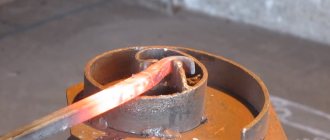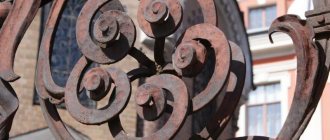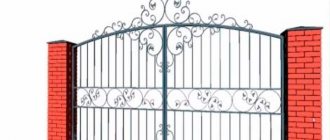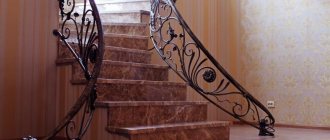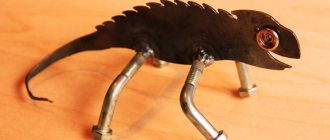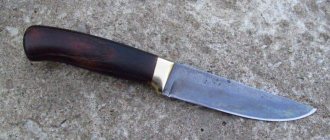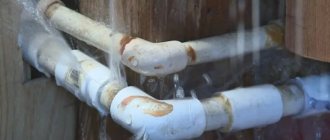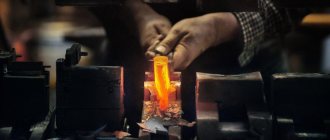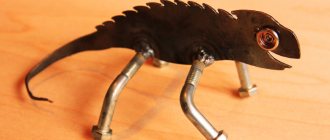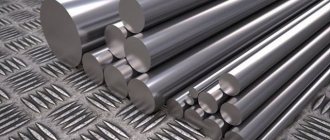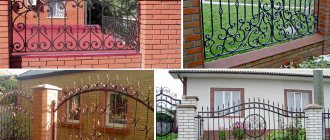Cold forging allows you to create various shaped products without heating. This processing does not require large-sized equipment and can be carried out in a small workshop. For each type of decorative element, its own devices are used. They are simple to make and accessible to a novice craftsman who knows power tools and welding. To create a rolling machine, purchase rolls and some parts.
Fences, railings for stairs and balconies - you can also do it yourself
Yandex.RTB RA-1479455-2
Canopy over the porch using cold forging
Porch railings are a decoration, not a purely utilitarian fixture.
You can make a gazebo and forged furniture
Gate like in a fairy tale
Yandex.RTB RA-1479455-7
Profile pipe and its features
Profile pipes of various sections are a durable, accessible and inexpensive material. In furniture production, it is ideal as a reliable frame: frames, stops, and table legs are made from pipes.
Main advantages of pipes:
- structural strength;
- reliability;
- ease of processing;
- variability of sizes;
- availability;
- low price;
- good compatibility with different materials
Pipes have a square or rectangular cross-section, the most popular thickness is from 10 to 40 mm. The larger the furniture and the greater the weight of the tabletop, the thicker the pipes used for the frame should be. As additional reinforcement, use the lower or upper trim. Such products are very stable.
The downside of the design is its impressive weight, which can be adjusted by choosing lighter materials for table tops and seats.
Furniture made from profile pipes can look deliberately brutal or elegant and weightless. If handled correctly, the products will be stable and safe, they will last for many years and will not require repairs. Finished furniture is easy to modify: just change the tabletop or repaint the profile pipe.
Machine tools as an alternative to tools
If you plan to organize home production, and not perform one-time work, it is best to purchase a combined machine for cold forging. It will take up significantly less space than the equipment separately.
Most models have an electric drive, which speeds up the production process. Contents and functionality depend on requirements. The average cost of such equipment is from 60,000 rubles.
Furniture style: how to make a choice
It is believed that a profile pipe is too rough and simple a material, suitable only for unassuming street benches or garden tables. However, with the right choice of material and proper skill, you can assemble completely unique things from pipes that are not inferior to expensive forged products. Even simple rectangular tables and reinforced stools can look stylish if they fit correctly into the interior.
From a profile pipe you can make:
- tables (dining tables, desks, coffee tables);
- bedside tables;
- consoles;
- garden furniture;
- stools and benches;
- bookcases;
- mattress frames;
- beds;
- serving tables;
- desks;
- bar counters;
- workbenches.
Furniture in high-tech, scandi, loft, and modern minimalism styles is most often made from profile pipes. In order for the product to look impressive and not resemble a budget homemade product, it is important to wisely select additions that soften the utilitarian appearance of profile pipes.
Deliberately rough, massive frames go well with natural wood, varnished or stained, tempered glass, natural or artificial stone, and metal. Bent structures will fit perfectly into interiors designed in the spirit of art deco, modern, and vintage.
Expert opinion
Korzhavin Daniil Dmitrievich
Designer of stylish home furniture
Metal parts can be painted in light colors; artificial aging, silvering, and gilding techniques are used. Much depends on the skill of the manufacturer, technique and materials chosen for finishing.
History of the forge: description of cold forging
Forging is a process of processing metal to give it the desired shape, turning a blank (blank) into a product. For people who are unfamiliar with the peculiarities of metal work, the word “forged” is associated with a forge, where a blank is heated from 800 to 1000 ° C and processed with a hammer to give shape. But in everyday life, items made by cold forging are more often used. Pots, teapots, patterns on gates and doors, metal stands are made by deforming metal under pressure without preheating.
Beautiful forged elements can be created even at home without the presence of special expensive equipment
Cold forging is an easier, safer and more ergonomic processing method than hot forging. Main advantages:
- equipment for cold metal forging is cheap and ergonomic;
- low labor intensity;
- quick job training, low qualification requirements;
- the ability to create a unique ornament from basic elements.
The downside is the limited working surfaces and materials: rods, sheets and plates.
Cold forging is one of the ancient methods of metal processing
Hand-made cold forging is historically older than hot forging. The first products were discovered in Egypt and Mesopotamia and date back to the 4th-3rd millennium BC. Initially, ore was used, which was deformable after being hit by a stone. Cold forging was used to make gold jewelry. Soft metal was easy to process with stone hammers. The oldest product was found in Egypt, it was made 8 thousand years ago.
Several centuries later, by observing volcanoes, people learned that high temperatures made it much easier to shape metals. They began to build blast furnaces and the profession of a blacksmith appeared. The Stone Age gave way to the Iron Age, and not only jewelry, but also dishes, weapons, and garden tools entered people’s lives. The principle of operation of the forge is still preserved, but the equipment for cold forging has been modernized.
Using modern equipment you can create products with a large number of forged elements
Basic tools for cold forging at home
The creation of a unique product always begins with material calculations and the development of a detailed work plan. The easiest way to think through the moves is to create scale sketches of forged products, write down the dimensions and select the necessary tools. The choice of material deserves special attention. The metal should be strong, but bend easily.
Important! Hardened sheets or rods cannot be used. Under the influence of temperature changes, the structure of the metal changes, it becomes brittle and can break under pressure.
There are two types of do-it-yourself metal forging - rolling (working with rods) and stamping (extruding sheets under a press). At home, the first option is more often used. To press sheets, you need to make a special blank for deformation. Common rolling tools: bender, snail, twister, wave and flashlight.
Cold forged elements can be used to decorate stairs
A bender is a basic tool used for bending rods at different angles. The spiral elements of cold forging are twisted using a snail. For shaping, it is best to choose rods with a diameter of 10-12 mm. Choosing a material that is too thick can significantly complicate the work of the master.
A twister machine is used to twist rods along the longitudinal axis. The wave, accordingly, is intended to create wave-like elements. The flashlight tool is used to work with several rods at once. They are installed on the equipment and bent by rotating the lever.
Related materials: the best combinations
For furniture, the frame of which will be a profile pipe, it is hardly worth choosing expensive wood. The ideal option for a countertop is regular plywood. It is quite light, durable, easy to process and suitable for various coatings. An equally good option is thin boards coated with plastic.
For coffee and dining tables with a bent openwork frame, thick tempered glass, transparent or tinted, is suitable. It is best to use a ready-made glass tabletop.
An inexpensive profile pipe is a reason to give a second life to old furniture. For example, a beautiful bed headboard and a welded pipe frame will make an elegant garden bench, a wardrobe door will replace a tabletop, and scrap boards will be useful for stool seats.
The size of the pipes is selected depending on the type of furniture. The general rule is that the greater the load, the heavier the pipe can be. For the home, it is better to use blanks with a thickness of 20-30 mm; for garden furniture, which moves less often and must be especially stable, a 40 mm pipe is suitable. All products are necessarily treated with an anti-corrosion coating, which is recommended to be renewed periodically.
Techniques for cutting round pipes at an angle
Round pipes of different diameters are cut at an angle when changing the direction of the pipeline, but it should be taken into account that a straight cut at the desired angle, unlike a rectangular section, will not lead to a tight connection of the edges. Therefore, special patterns are used in which the marked edge has a curved shape, which makes it possible to obtain a high joint density.
Paper pattern for pipe
One of the common ways to make a pattern for pipes with a round surface is a method for which you will need a lined sheet of paper, a ruler and a pencil. To obtain a paper pattern proceed as follows:
- Draw a circle on a piece of paper with the diameter of the pipe being cut, divide the circle into 16 equal segments, each time dividing large segments into two equal ones.
Rice. 6 How to cut a pipe at 45 degrees - paper pattern
- Measure the length of the circle by multiplying its diameter by the number Pi equal to 3.14. Lay this dimension on both sides of the axis of the circle in equal segments, each of which is divided into 8 equal parts.
- Draw vertical lines upward from segments on a straight line and horizontal lines from points placed on the circle.
- The places where they intersect are connected by a smooth line and, as a result, a template is printed on paper, which is cut out and glued to the surface to be trimmed. For trimming, it is better to use a grinder with a disk of small diameter - the surface will be curved and when using a large disk, the error will increase.
DIY home furniture
It’s better to start with the simplest designs possible: a variety of tables and stools. You shouldn’t invent models yourself: all interesting solutions can be found on the Internet or specialized magazines. It is enough to choose an interesting option of the desired size and calculate what materials will be needed for implementation.
Kitchen table
Kitchen tables must be stable, withstand daily loads, and have a simple but attractive appearance. The best option is a tabletop with a reinforced structure.
The main load falls on the frame and legs, so for their manufacture it is worth choosing a square profile pipe with an edge of at least 40 mm. Additional crossbars are not needed; this will allow you to place roll-out structures with drawers or shelves, pipes, and household appliances under the table.
The tabletop can be made from boards with a waterproof coating, durable plastic, artificial stone or MDF. Depending on the design decision, the profile is painted to match the tone of the tabletop or made in contrast.
Living room table
For a living room in a classic style, an elegant coffee table about 35 cm high can be made from a pipe with a 10 mm edge. The desired shape is given using a pipe bender; in the middle part, the legs are connected by a transverse beam. For additional openwork decor you will need round fittings. The design is quite light, so it is better to use plastic or plywood for the tabletop.
garden bench
For benches it is better to combine metal with wood. The seat is made of wide slats mounted on a welded frame made of pipes 30 - 40 mm thick. Garden furniture must be stable, so the lower base is made in the form of a closed rectangle. It is necessary to coat metal parts with an anti-corrosion compound.
45 degree cutting
Typically, in order to rotate a pipe by 45 degrees, fittings and bends with a rotation angle of 45 degrees are used, made of the same material as the pipes themselves; if the pipes are steel, then the turns are welded from steel. For HDPE pipes, there are electric-welded or cast bends at 45 degrees (note that it is almost impossible to find compression fittings with this angle of rotation in Russia).
But, if you still need to cut a round pipe made of steel or various types of plastics, then for this you will need a pattern for cutting pipes at an angle, the shape of which is calculated manually or by machine. The task is greatly simplified if it is necessary to cut a square metal profile at an angle of forty-five degrees.
For quick cutting, you can use a regular sheet of paper folded diagonally to mark the surface for future cutting. When using folded paper, proceed as follows:
- carry out on a straight surface of the profile in the place where the cut is made, strictly perpendicular to the line;
- apply a sheet of paper folded diagonally to the side surface with the sharp end to the line so that the upper edge of the paper triangle is flush with the top side of the metal profile.
Rice. 2 Homemade template for cutting pipes at 45 degrees
- draw a line with a pencil along the side of the sheet at an angle of 45 degrees, after which the paper corner is applied to the other side and traced with a pencil (it is better to use a thin marker).
For sawing, you can use a grinder with a metal disc, first drawing a thin line along the marking, and then gradually deepening it until the edges are completely separated.
When working with an angle grinder, the following factor must be taken into account: if the edges are completely cut, the disk may be damaged by a sharp corner, which will lead to its failure, and in the absence of protection on the angle grinder, even to injury to the worker. Therefore, it is advisable not to cut the corner edges to the end, but to leave a narrow groove and then break them off, subsequently grinding the protrusion.
Making a template for cutting metal profiles
If you need to cut a large number of pipes, you can make a template from a metal profile of a larger diameter using a paper sheet using the above method. The angle of inclination is checked with a protractor or a construction square - in this case, the two edges of the cut parts of the template are connected.
When working, a template is placed on the part to be cut in the right place and pressed tightly, the markings are applied with a sharply sharpened scriber while tracing the template outline. The part is cut in several passes with a gradual deepening of the groove.
Rice. 3 Cutting a metal profile using a miter box
DIY miter box for cutting pipes
Using a template is not very convenient - you have to make a cut along the line, holding the grinder in weight, which leads to large errors. If you have a welding machine, you can make a simple miter box - guides for the grinder disk, preventing it from moving to the side.
To do this, use a previously made template, drill a hole in the side of which and weld a nut. When working, a homemade miter box is placed on the profile, a bolt is screwed into its nut and the device is pressed against the profile surface. A grinder with a metal disc is used to make a cut, lightly pressing the disc against the side surface of the device. It is clear that with prolonged use, the edges in the miter box are gradually ground down, and although the process occurs simultaneously on all edges, some errors will appear over time. Therefore, it is better to make the device from hard, wear-resistant metal in order to increase its service life and obtain a more accurate instrument.
Questions and answers
I want to make a light table for the balcony. Is it possible?
Use pipes with a thickness of no more than 10 mm, welding them crosswise and without using the bottom trim. The table can be folded.
There is a dining table with a frame made of a profile pipe, a wooden tabletop. What chairs should I choose for it? Maybe make it in the same style, with a frame made of pipes?
It all depends on the style of the kitchen or dining room. Stools made from profile pipes look good, but they have a drawback - they are too heavy. Choose neutral wooden chairs in a matching color scheme, they are much more practical.
How to strengthen the structure of the table without using too thick a pipe?
The simplest option is a tabletop with a reinforced frame. For maximum stability, install 2 welded rectangles instead of legs, connecting them with a crossbar.
Is it possible to make a bed frame from profile pipes?
Of course, but it will turn out very heavy. To make the structure lighter, it is worth abandoning the headboard, welding only the frame for the mattress on legs with lining of the sides. To secure the mattress you will need a slatted bottom.
Purpose of the method
Cold forging is characterized by various curls, bends, twisted rods, etc. Almost every type is made on a separate device - a specific machine. They can be driven manually or electrically. For small volumes “for yourself”, manual cold forging machines are used. Although they are not particularly productive, they are much easier to manufacture. If it is necessary to put production on stream, similar devices are made, but with electric motors. In this case, there is almost no need to physically work, but the complexity of making the device increases significantly. In our material we will talk about manual machines for cold forging.
What devices are used:
- Torsion bars. With their help, tetrahedral rods or strips of metal are twisted in the longitudinal direction. The result is twisted columns, which are also called torsion bars. This is what a torsion bar and the machine of the same name look like
- Flashlight. On this device, the rod is also twisted in the longitudinal direction, but it is also additionally bent in the transverse direction. It turns out something similar to a flashlight. Hence the name of the device. This is how they make a flashlight
- Twisters or snails. Form flat curls of different diameters. Device for cold forging snail - for forming curls
- Bending machines or benders. Allows you to bend rods or reinforcement at the required angle anywhere. For bending anywhere and at any angle - bending machines (bending machines)
- Wave. In fact, this is also a bend, but of a more complex design - it allows you to change the direction of bending, obtaining wavy parts. Machine "Volna" - for the formation of the appropriate relief
- Devices for processing the ends of parts - inertial stamping machines or other home-made devices. Machines for shaping the ends of rods. In this case - crow's foot
Yandex.RTB RA-1479455-3
For a beginning craftsman, the most relevant machine for cold forging is a snail. Only with its help you can make many interesting things - from a fence and gate to a bench and other similar products. In second place in terms of necessity is a torsion bar machine. It adds variety to the details. All the rest can be purchased or made as you improve and gain skill.
Pros and cons of wrought iron furniture
- The first main thing is durability, strength, reliability. It does not deform over time and is not susceptible to damage from insects. Of all the possible types of furniture, this is the best option for the category of things “forever.”
- Special and unique aesthetics.
- The ability to give the interior a more expensive and solid look without investing much money.
- Forged furniture is out of fashion; when designing it, the question will never arise whether it is fashionable. Plus, it can be done in a variety of artistic styles.
- The versatility and “partnership” of metal in relation to other materials: natural and artificial materials are perfectly combined.
- Environmental Safety.
Article on the topic: Do-it-yourself furniture with a carriage screed
The disadvantages cannot be ignored:
- Massiveness, heaviness. These properties become a disadvantage only in cases where the owners often move from place to place or like to rearrange the house.
- Forged furniture is not very suitable for small apartments. Of course, forged chairs with a table can be made elegant and visually airy, but they do not fold and require their own space in the apartment. Forged furniture is not very friendly with other interior items; it has its own character.
- Metal surface that is cold to the touch. This disadvantage can be eliminated with the help of modern polymer coatings.
As you can see, forged furniture has many more advantages than disadvantages. These products have occupied a special place in interior design for centuries. Making your own pieces of metal furniture is an exciting, creative and very profitable endeavor. We wish you success!
Types of forged products
The most common products that are usually used to decorate the garden area are:
- Fences and gates. They look especially elegant, and sometimes even luxurious. However, they are entrusted with a difficult mission: along with aesthetic functions, they must also perform a protective function.
- Garden furniture (entirely, or with individual forged elements) - its aesthetic qualities, along with strength and durability, will not leave indifferent even the most sophisticated connoisseurs of beauty and elegance.
- Bridges in the garden, decorated with openwork curved patterns, look very elegant, sophisticated and aristocratic. If there is a stream or alpine hill, as well as other exotic vegetation on the site, an element such as a bridge will perform not only a decorative, but also a protective function.
- Stairs and all kinds of supports look very elegant and decorate the porch and terrace.
- Arches and pergolas. Nowadays, they are used not only to create a secluded shady area in which you can relax and enjoy the coolness on a hot summer day. Quite often they act as an independent architectural element. They can be decorated with rose bushes and entwined with vines. That is, they also perform several functions at the same time: aesthetic and practical.
- Barbecues. What would an outdoor holiday be without a barbecue? But not all barbecues fit organically into the surrounding design. Forged barbecues come to the rescue here, adding extraordinary color and comfort to the surrounding space. Here you can show all your imagination, because the process of artistic forging provides for a variety of forms and intricacy of the plot.
- Garden lamps will become the highlight of your garden plot design. All kinds of lanterns decorating the walls of the house and located along the paths will create a romantic mood and bring harmony to the surrounding space.
- Gazebos and canopies. They are usually placed some distance from the house or near a body of water. They serve as a kind of relaxation or privacy area. The airy and light structure evokes a feeling of celebration and puts you in an optimistic mood. A variety of canopies and canopies are designed not only to protect from rain and snow, but also to contribute to the creation of the overall architectural composition.
- Accessories. Flower stands, forged figurines, umbrella holders, garden lamps, door knockers and other items will undoubtedly bring color to drab everyday life. Moreover, these accessories and much more can be made with your own hands.
Article on the topic: DIY round table
But is it so easy to make a forged product with your own hands at home?
Types of forging
Many people believe that creating forged products with their own hands is almost impossible. Others believe that there is nothing complicated about it, because blacksmithing has existed for a very long time and our ancestors were successfully engaged in it. However, in order to make even the most simple forged element on your own, you must have certain skills and, preferably, experience in this difficult task. In addition, one cannot do without special tools and knowledge of the properties of various metals.
Hot forging is a labor-intensive and difficult process that is carried out in forges and cannot be done at home.
Without special conditions, an analogue of hot forging is suitable - artistic forging.
How to cut a cast iron pipe
The main difference between cast iron and ordinary steel is its high fragility and large wall thickness; its precise cutting must be performed in the following sequence:
- The marking angle is drawn according to the template using a scriber, for
supports under the part are placed on a wooden board or board.
- Use a grinder to make a shallow cut of the surface around the entire perimeter.
- Next, the groove is deepened in several passes until the two parts are completely separated.
The importance of style matching
Forged forms used in garden design should in no case fall out of the general style in which the main structure and the entire site are maintained.
Otherwise, even a beautiful product may feel alien. Therefore, when placing an order or choosing an ornament for independent work, you should study the samples of artistic forging as carefully as possible. Article on the topic: DIY plywood children's furniture drawings
The appearance of forged elements must correspond to the overall style of the garden
In general, forged elements fit perfectly into any type of landscape. They are appropriate in the precise clarity of French parks, perfectly combined with the emerald greenery of English lawns, deftly fit into the usual Russian manor comfort, and for the fountains and marble of an Italian garden they are simply an integral part.
What is important here is the number of elements in the forging and the ornament itself. Many small details, splendor and volume of the product are not suitable for every garden. The heavy Baroque style is appropriate on a large area, where there will definitely be details that echo the ornaments and a house made in the same spirit. But for a light and thin forged product, no special conditions are needed - it will fit perfectly into any landscape.
How to weld a fitting correctly
In order to perform a beautiful and reliable installation of the pipeline and weld a 90-degree bend to the pipe, you need to choose the right welding machine and electrodes. It is better to look for this information on specialized forums, where experts will be happy to tell you what electrodes and operating modes of the welding machine they use in their professional work.
Pipeline parts are welded using the butt welding method, which is when the edges fit tightly to each other. The thickness of the electrode for such work is taken to be 2-3 mm at a welding voltage of 80-110 Amps. In order for as little burnt metal as possible to get inside, the electrode must be positioned at an angle of 45° to the surface. It is advisable to weld round pipes in one continuous seam. After welding, you must wait until the seam has completely cooled down and beat off the slag, and only then proceed to the next seam.
In order to get beautiful and even seams, you need to fill your hand, so don’t despair if it doesn’t work right away. Practice first by welding just small pieces of pipe. And only after this should you proceed directly to welding the pipeline.
